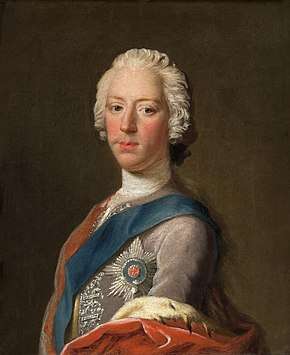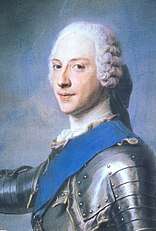Lost portrait of Charles Edward Stuart
The "lost portrait" of Charles Edward Stuart is a portrait, painted in late autumn 1745 by Scottish artist Allan Ramsay, of Charles Edward Stuart, also known as the Young Pretender or Bonnie Prince Charlie.
| The Lost Portrait of Charles Edward Stuart | |
|---|---|
 | |
| Artist | Allan Ramsay |
| Year | 1745 |
| Medium | Oil on canvas |
| Dimensions | 30 cm × 25 cm (12 in × 10 in) |
| Location | Scottish National Portrait Gallery |
The painting was discovered by art dealer and art historian Dr Bendor Grosvenor at Gosford House, the home of the Earl of Wemyss near Edinburgh,[1] and was authenticated by the Ramsay authority Dr Duncan Thomson, former Director of the Scottish National Portrait Gallery,[1] where the painting is now held.[2]
Background
In 2009, Grosvenor revealed that the subject of the best-known portrait of Charles Edward Stuart,[3] the 5-foot (1.5-metre) pastel by the French artist Maurice Quentin de La Tour that had been hanging in the Scottish National Portrait Gallery since 1994,[4][5] was in fact of Charles's younger brother Henry Benedict Stuart.[1] This portrait had until then been widely reproduced and was "immortalised on countless tins of shortbread",[3] as well as appearing in the entry for Charles in the Dictionary of National Biography and countless book covers, postcards and souvenirs.[3] Grosvenor said: "Bonnie Prince Charlie is one of my heroes, and I always felt bad about debunking what used to be his most famous portrait. So I'm delighted to have found the best possible replacement – a portrait painted from life on the eve of his invasion of England."[6] Whilst attempting to find this replacement – an authentic painting of Charles from the period of the Jacobite rising of 1745 – Grosvenor discovered a letter in the Royal Archives from John Stuart, the valet to Charles, that instructed Ramsay to go to Holyrood Palace in Edinburgh to paint Charles's portrait:[3][5]
“Sir, you are desired to come to the Palace of Holyroodhouse as soon as possible in order to take his Royal Highness’ picture. So I expect you’ll wait no further call. I am, your most humble servant, John Stuart, Holyrood House 26th of October 1745.”[7]
He also found a black and white photograph of the Ramsay portrait in the records of the National Portrait Gallery in London, although the artist was not given as Ramsay.[5] This painting was at Gosford House, the home of the Earl of Wemyss, where it had hung in increasing obscurity for 250 years in a gloomy corridor on the ground floor.[3] The painting was known to be of Charles but it was not known that Ramsay was the artist.[7] Ramsay authority Dr Duncan Thomson, former director of the Scottish National Portrait Gallery, authenticated it as a work by Ramsay and said: "This portrait brings the prince back to life in a way I'd never thought imaginable. It's hard to overstate the importance of finding a portrait of the prince painted in Scotland, by a Scottish artist."[5]

On 30 March 2016, the Scottish National Portrait Gallery announced that the painting had been acquired for the nation through the acceptance in lieu scheme, with the painting being valued at greater than £1.1 million.[2] It was placed on display at the Scottish National Portrait Gallery just before the 270th anniversary of the Battle of Culloden.[2]
Painting
The small painting, 12 by 10 inches (30 by 25 centimetres),[7] is the only one of Charles known to have been painted in Britain.[5] The painting was intended to be taken to England and be both reproduced in engravings and used as the "basis for an official royal portrait" once Charles had ascended to the throne.[3] Christopher Baker, the director of the Scottish National Portrait Gallery, said on the painting's acquisition that:
"It is a little gem of a picture, almost on a miniature scale, which was likely produced on that scale because it was planned from the outset that it would be replicated as prints. It becomes the key source for an awful lot of propaganda to support the Jacobite cause, which were widely distributed, not just in Scotland, but right across Britain and Europe."[2]
BBC programme
The story of Grosvenor's research into and discovery of the painting was the subject of a BBC documentary titled The Lost Portrait of Bonnie Prince Charlie, which was broadcast on BBC Two on 22 February 2014.[1]
References
- "Lost Bonnie Prince Charlie portrait found in Scotland". BBC News. 22 February 2014. Retrieved 23 February 2014.
- Ferguson, Brian (30 March 2016). "Unique Bonnie Prince Charlie painting secured for Scotland". Edinburgh News. Retrieved 1 April 2016.
- Kennedy, Maev (21 February 2014). "Bonnie Prince Charlie portrait found by art historian Bendor rosvenor". The Guardian. Retrieved 23 February 2014.
- Cramb, Auslan (15 December 2009). "Gallery admits portrait is not Bonnie Prince Charlie". Daily Telegraph. Retrieved 17 March 2014.
- "Scottish portrait of Bonnie Prince Charlie rediscovered". Herald Scotland. 22 February 2014. Retrieved 23 February 2014.
- Callaghan, Carla (21 February 2014). "One and only portrait of Bonnie Prince Charlie painted in Britain is discovered in Scotland after 250 years". Daily Record. Retrieved 23 February 2014.
- Ross, Shân (23 February 2014). "Bonnie Prince Charlie portrait found in Scotland". The Scotsman. Retrieved 23 February 2014.